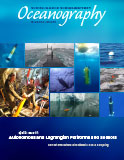Article Abstract
We have been mapping the ocean for hundreds of years, from the stick charts of the ancient Marshall Islanders, to the initial soundings of the nineteenth-century Challenger expedition, to the multibeam sonars and robots of modern surveys. Today we map the ocean not only to increase fundamental scientific understanding of the ocean system but also to protect life and property, promote economic vitality, and inform ecosystem-based management and policy. Toward this end, the United Nations Sustainable Development Goals provide an overarching context for modern map development, drawing upon a vast wealth of maps and mapping experience that couples appropriate data with spatial analyses. At the same time, there is an overarching need for more compelling map design to help effectively communicate results and future predictions across a wide variety of research areas. Indeed, modern-day mapping systems have become increasingly “intelligent,” and these “smart maps” are changing what we measure, how we analyze and evaluate systems, how we forecast, and even how we develop new regulations. Intelligent maps are addressing myriad challenges, from the tracking of marine debris and marine mammals, to “geodesigning” the ocean to support multiple uses (commercial fishing, recreation, alternative energy, transportation, conservation), to creating scientific cyberinfrastructures for ocean observatories. Yet “there be monsters”—the major research challenges that continue to confound us. Despite the growing intelligence of mapping systems, we must cope with both the overabundance and the paucity of ocean data (i.e., “big data” and “dark data”), data multidimensionality, the need to increase data resiliency, and the ability to make data more accessible to many audiences. How do we address these major issues to create open and effective access to ocean science that will contribute to the global public good and ultimately to the sustainability of Planet Ocean?

